| Posting Rules | | post new threads post replies post attachments edit your posts is are code is are are are | | Similar Threads | | Thread | Thread Starter | Forum | Replies | Last Post | | | Whisper2Me | Meets & Greets | 16 | 04-01-2014 06:28 | | | silverp40 | Deck hardware: Rigging, Sails & Hoisting | 9 | 17-11-2013 07:33 | | | hellosailor | Seamanship & Boat Handling | 33 | 20-10-2012 12:51 | | | FraidNot | Deck hardware: Rigging, Sails & Hoisting | 3 | 27-02-2011 13:31 | | | sandycohen | Deck hardware: Rigging, Sails & Hoisting | 1 | 20-12-2009 08:01 | Privacy Guaranteed - your email is never shared with anyone, opt out any time. Home » LIST of WOODEN BOAT PLANS – By Michael Storer » Viola 14 Sailing Canoe Plan – plywood sailing dinghy » Rigging details for the Viola 14 Sailing Canoe » Build two simple light strong rudderboxes for the Viola 14 sailing canoe and sailboats Build two simple light strong rudderboxes for the Viola 14 sailing canoe and sailboatsSimpler method of making a rudder setup for sailboats including the Viola 14 canoe is a direct descendant of our original dagger rudderbox carrying on the light but strong and easy to build construction. This article is a resource for sailing canoe and outrigger canoe rudder builders. Other boats are better off with the dagger rudder for the reasons below. This section is built around text and images by Joost Engelen about setting up the Viola swing rudder and the design simplifications we worked out. But overview and discussion between the two types is by Michael Storer. Viola Sailing Canoe info More Rigging Details for the Viola 14 Canoe So why a different rudder setup for a sailing canoe when the dagger system is usually far superior?On all of our sailing dinghy designs we use a dagger rudder setup with a bungee/shockcord loaded open back. Apart from older designs from the Northern Hemisphere we seldom see swinging rudders on Australian raceboats. Epoxy has low clamping pressure – so tape is enough. They use a dagger system with the blade sliding up and down. Either with an open back or a closed back Get a PLAN – Bolt placement is CRITICAL and some important contstruction tricks – get it wrong and it will break. Get it right and it will have a very long service life. – the best way to get the design (and details on making spars, super accurate foils, scarfs, butt straps, even sail making) is buy buying the $36 Oz Goose Plan . The advantages are several. - Simple to make
- Strong and very reliable as long as you put in the required bolts
- Yes … read the above point again. Don’t forget the designed bolts or it will break very quickly
- Steering loads go from tiller to rudderblade directly
- Nice accurate light steering in any water depth . Unlike a swinging blade where a little kickback gives almost no reduction in draft but creates very high tiller loads and the risk of breaking the box.
- Low loads at speed where a swinging blade at speed it can kick back a little producing very hard to deal with tiller forces.
- Handles hitting the bottom – if the blade grounds out it will swing backwards and once over the obstruction will pop back down again.
The big win is very light and positive steering in any depth of water. Once used it makes so much sense from a practical and construction point of view it is clear why we seldom see swinging rudderblades in the antipodes. However … with this type of rudder setup, it needs to be pushed down manually. Moving to the back of a skinny light sailing canoe can be tricky. So it is a good idea to have a swinging canoe rudder blade blade and design out as many drawbacks as possible. There are some important parts of the detail to make it strong.If it breaks it is your fault for not building it right. These are non obvious involving the bolt through the tiller and the ply or glass around the end of the tiller to prevent splitting. The cheapest way to get the most up to date plan for the dagger rudder is to buy the Oz Goose plan for $36. Buy Oz Goose Plans Where the Dagger Rudder with kickback came from – Paper Tiger Catamarans circa 1973I don’t want to claim this as my own work. Like most of my good stuff, it is stolen. But I am a careful student of excellence that actually works. In this case, Jay Booth (father of well known International sailor Mitch Booth) took me along to see my first big Catamaran regatta. Saw Paper Tigers for the first time. They are probably the quickest non-trapeze 14ft cats. Very light – 50kg platform (110lbs) plywood or foam/glass. Ron Given, the designer had come up with the same dagger and kickback rudder setup. As a 13 year old, I mentally went “wow” and filed it away. My first and second boats had swinging rudders and I could see the advantages of the Paper Tiger System. When I moved up into NS14s I started making and breaking dagger rudder boxes. It took me a few seasons of making rudderboxes this way to get it right. I broke a lot of them before I realised the placement of the bolts was critical. After that – very reliable. The one flaw of the dagger rudder system – narrow boats.In many sailing canoes, the stern is quite narrow so it is hard to go to the back of the boat to manually push the canoe rudder blade down. Wobbles and potential or real capsize! So with the Viola 14 Sailing Canoe, we needed something that worked well but had the maximum simplicity and minimum weight. The bad way – poor structural efficiency of a normal swinging rudder leads to heavy and complex construction.So what were the problems with the usual swinging rudder setup? … Or What are the funny shaped green bits for? - Conventionally the tiller is at the top and the pivot for the rudderblade is at the bottom. This means the torque from turning the tiller has to be transmitted from the top to the bottom by the rudder box.
- The spacer is fiddly to get right and prevents full vertical retraction of the blade
- If spacer is omitted the cheeks have to be very thick.
In comparison the dagger system has two faces of 5mm ply and a single spacer 25 thick running up the front edge. No special shaping and all the components can be light because the rudderbox is very lightly loaded. Even if it hits something the blade is free to move backwards. So as the principle of the dagger rudder setup is that the tiller turned the blade directly – the box was not carrying any turning loads – then we had to do the same for the swinging canoe rudder. So the pivot for the swinging rudder moved up to be controlled directly by the tiller. This took the load off the rudderbox. The internal spacer between the cheeks to be a simple rectangular piece of timber like our drop in boxes saving weight and general messing around with complicated and heavy bits. And the rudder cheeks could be thin like the hull ply. But note that like the dagger rudderbox, the bolts in the structure do important work. Holding a swinging canoe rudder down – the ways that work and the ways that don’tIf you boat is very slow it is possible to get away with a weighted swinging rudder – even if you choose to ignore Uffa Fox (the father of the planing dinghy some say). That “weight only belongs in Steam Rollers”. Remember that sailing canoes were the fastest human made means of transport for quite a few decades. So your canoe or outrigger canoe will hit serious speeds at times and you don’t want the rudder coming up a bit on you. The problem is that even if the boat is a little faster than slow :) the rudder will creep up a little and the tiller loading becomes very high just as you need the best control possible. Not a good thing. Same if you use bungee to restrict the swinging blade – can’t get the bungee far enough away from the pivot to be useful. And then a bit more speed again up pops the canoe rudder. High tiller loads, veer, splash. Or rudderbox breaks. It took me a while to understand this too and it led to more than a few capsizes in the Lightweight Sharpies I was sailing at the time. They inherited the swinging rudders from the 12sq metre sharpie class they were derived from. When the rudder lets go or takes control because the blade has rotated back – this is what happens on a very fast 20ft light dinghy. In the old days we used stainless steel wire to hold the swinging rudders down totally positively on fast boats. Happily we can now use spectra rope and avoid the steel spikes that rip your skin open like a scalpel after a half season of use. We often used a relatively weak cheap cleat that would break if we hit anything hard. Rudder pivot for the Viola 14 Sailing Canoe rudderboxThe rudder downhaul is necessary to keep the foil down. The uphaul is optional; not really necessary when just using the boat for sailing since the foil will float up nicely (after all it is all timber with some glass!), but necessary for when using the boat for cruising and having to paddle (when paddling hard the rudder will start to steer the boat which is annoying). Insert the swinging rudder blade in the rudder stock so that the holes in the rudder stock and the hole in the foil taking the bolt line up. Insert the bolt and put the nuts on. Use big washers on the outside of the bolt to distribute the forces over a larger surface. Do not overtighten the nuts on the bolt, just tighten them up by hand. Too tight and your swinging rudder won’t swing! If using 2 nuts on each end, one can tighten these against each other using spanners and this will avoid them coming loose. Use cap nuts, or better Nyloc nuts on the outside to avoid having any sharp bits. If using Nylocs you don’t need a lock bolt If you can get a bolt with a plain shaft then do so. Downhaul for the Viola 14 RudderboxThe downhaul ends up in a clam cleat. One could use a auto release clam cleat if afraid for hitting something with the canoerudder unexpectedly (SD-002570 Auto-Release Cleat). The rudder is not very deep though, but make your choice in accordance with your specific needs. A cheaper way is to use a cleat that will break or slip if you hit something hard. We used to use something like this in a fairly small size to go with the 3mm rope we used. In the photos the downhaul consists of a 3mm rope with Dyneema core pre-lead line and a regular polyester 4mm control line that stretches. Due to the stretch in the downhaul control line it is easier to tension the downhaul and to get it out of the cleat again. To obtain the correct position for the hole in the swinging rudder blade for the downhaul attachment, rotate the board in the cassette until the leading edge of the rudder passes the aft bottom corner of the rudder cassette. Mark this place and drill the hole just below this mark to ensure that the downhaul attachment point will clear the rudder box when the rudder rotates in its case. Obviously you will need to drill the hole 20mm or so back from the leading edge. It would be wise making an epoxy bushing for the downhaul attachment hole which is very simple to make as follows: - drill the hole oversize first,
- fill the hole with epoxy glue using packaging tape on the other side and,
- only then (when the glue has hardened) drill the final 4mm hole necessary for the 3mm pre-lead line. This avoids any potential water ingress.
Rudder Uphaul for the Viola Sailing Canoe Swinging RudderboxThe rudder uphaul is very important for paddling the canoe. If the canoe rudder drags in the water then steering with the paddle doesn’t work very well as the boat will slowly turn left or right. Or the nose will blow away from a cross wind. The rudder uphaul is a very simple affair on the Viola 14 canoe. A hole is drilled in the rudder head aft of the centreline of the foil and a rope is attached to this hole by a simple knot on the opposite side of the where the clam cleat for the uphaul is located (please refer to the first photo of the Viola canoe rudder setup and its controls above for the exact location of the hole in the rudder head). Obviously, the same comments apply in respect of making an epoxy bushing for the uphaul attachment hole. The rudder uphaul runs directly to the clam cleat. Very simple and it works great. A 900mm long tiller extension is suggested mounted right at the front of the tiller. All our sailboats have these types of rudderbox for ease of building and pure useful function. Our Plans are really well thought through.  MacGregorSailors.comDiscussions relating to the MacGregor line of trailerable sailboats Skip to content  - Main Site Board index MacGregorSailors Forums Repairs and Modifications
Rudder up and downhaulPost by Chumpy36 » Sat Jul 20, 2024 1:56 am Re: Rudder up and downhaulPost by LordElsinore » Sat Jul 20, 2024 3:46 am  Post by Jimmyt » Sat Jul 20, 2024 1:02 pm  Post by Gotro » Sat Jul 20, 2024 3:40 pm Post by Gotro » Sat Jul 20, 2024 4:41 pm 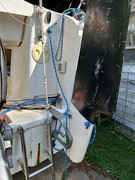 Post by Gotro » Sat Jul 20, 2024 4:45 pm 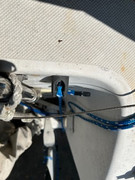 Post by Chumpy36 » Sun Jul 21, 2024 1:01 am  Post by NiceAft » Sun Jul 21, 2024 2:27 am Post by Jimmyt » Sun Jul 21, 2024 3:42 am Chumpy36 wrote: ↑ Sun Jul 21, 2024 1:01 am I guess i'm still al ittle confused by the stock hold down (Which I still have, just not attached). .. But how does the stock hold down work? Is it supposed to keep it down just like a bolt through the rudder holder? Where does it attach on the top end? How does one use it? Thanks Post by Chumpy36 » Sun Jul 21, 2024 3:03 pm Post by Chumpy36 » Mon Jul 22, 2024 3:46 pm 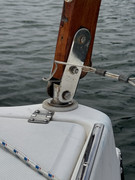 Post by Jimmyt » Mon Jul 22, 2024 6:55 pm Chumpy36 wrote: ↑ Mon Jul 22, 2024 3:46 pm Here are some pics. I thought I had some of the bottom of the castle and rudder but the aircraft cable just comes out the bottom to attach to the rudder. Do I attach a line to the aircraft cable loop at the top and then use a cleat that will allow the line to pop off if it hits something? Anything else I'm missing?  Post by Chumpy36 » Mon Jul 22, 2024 8:43 pm  Post by Newell » Mon Aug 26, 2024 2:27 am Chumpy36 wrote: ↑ Mon Jul 22, 2024 8:43 pm Got it. Thanks! Return to “Repairs and Modifications” - MacGregorSailors Forums
- ↳ Website News & Announcements
- ↳ MacGregor Powersailor Discussion
- ↳ MacGregor/Venture Discussion
- ↳ Performance & Tuning
- ↳ Trailers & Towing
- ↳ Repairs and Modifications
- ↳ Destinations, Clubs, Events and Venues
- ↳ Trip Logs
- TattooSailors Forums
- ↳ Tattoo Yachts Discussion
- Special Interest Forums
- ↳ Australia Group
- ↳ Canada Group
- ↳ European Group
- ↳ Rest of the World
- ↳ Admiral's Galley
- ↳ The Front Room
- Main Site Board index
- All times are UTC+01:00
Powered by phpBB ® Forum Software © phpBB Limited Privacy | Terms  Fast Dispatch, Fast Delivery and a 5 Star Rated Service  - MENS SAILING CLOTHING
- DYNEEMA TRAPEZE LINES AND ROPES
- SINGLE SHEAVE BLOCKS
- Gelcoat Fillers
- Dry Lubricants
- Adhesive Glues
- Hooks & Clips
- Catamaran Launching Trollies
- Jockey Wheels
- Hitch Locks
- Lighting Board
- Breakaway Cables
- Clew Straps
- Upper Masts
- Lower Masts
- Rope Thimbles
- Wind Indicators & Burgees
- Parrel Beads
- Whipping Twine
- Sailmakers Palm
- Digital Compasses
- DEVOTI ILCA
- LASER SAIL BOATS & DINGHYS
- BAHIA SAIL BOATS & DINGHYS
- Numbers & Letters
- Dinghy Covers
- Under Covers
- Catamaran Covers
- Single Handed
- Double Handed
- 18 Foot Skiff
- Exocet Moth
- Musto Skiff
- Dart 15/ Sprint 15
- Hurricane 5.9
- Laser Bahia
- Laser Cascais
- Laser Funboat
- Laser Stratos
Your Cart is Empty Tax included and shipping calculated at checkout Order before midday Monday to Friday and we will ship your order the same day. - 01268 222912
- Accessories
- Laser Products
- Sails & Covers
- Rope Lengths
- Parts By Boat
- Boat Care & Cleaning
- Splicing Tools
- Boat Covers
- Dinghy Rope Lengths
- Laser Rope Lengths
- RS Rope Lenghts
- Catamaran Rope Lengths
- Laser Performance
- Topper Sailboats
- Other Boats
 - Mens Sailing Clothing
- Womens Sailing Clothing
- Junior Sailing Clothing
- Repair Kits
- Skiff Suits
- Life Jackets
- Trapeze Harnesses
- Buoyancy Aids
- Hiking Pads & Pants
- Hiking / Toe Straps
 Zhik Superwarm - 100m Rope Reel
- 50m Rope Reel
- Polyester Ropes
- Control Lines
- Double Braids
- Braid On Braid
- Anchor Lines & Ropes
- Spools & Reels
- Windsurfing
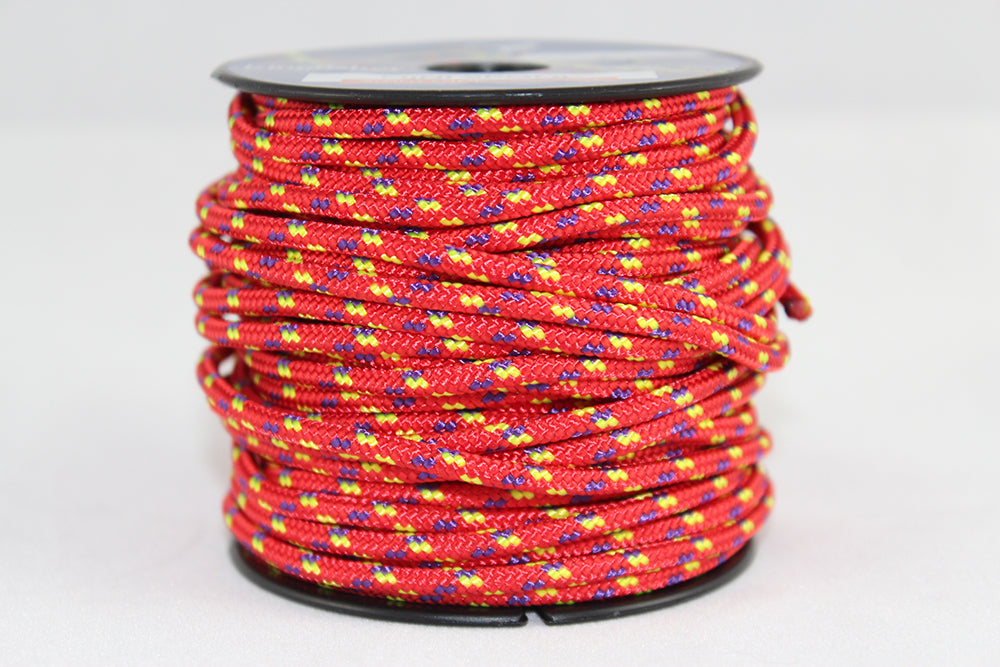 Mini Spools - Single Block
- Double Block
- Triple Block
- Soft Attach
- Split Rings & Pins
- Inspection Hatches & Covers
- Bungs & Sockets
- Rudder & Tiller Parts
- Bushes & Fairleads
- Marine Screws
- Penny Washers
- VHF Aerials & Antennas
- Marine Tapes
- Traveller Systems And Parts
- Traveller Blocks
- Pico Hull & Deck Fittings
- Hull & Deck Fittings
- Laser Boats
- Laser Sails
- Laser Sail Packages
- Laser Spars
- Laser Rig Packages
- Laser Foils
- Laser Hull & Deck Fittings
- Laser Ropes
- Laser Dinghy Covers
- Devoti ILCA Boats
- ILCA Sail Packages
- ILCA Rig Package
- Devoti D-Zero Boats
- Devoti KDK Boats
- ILCA Charter Boats
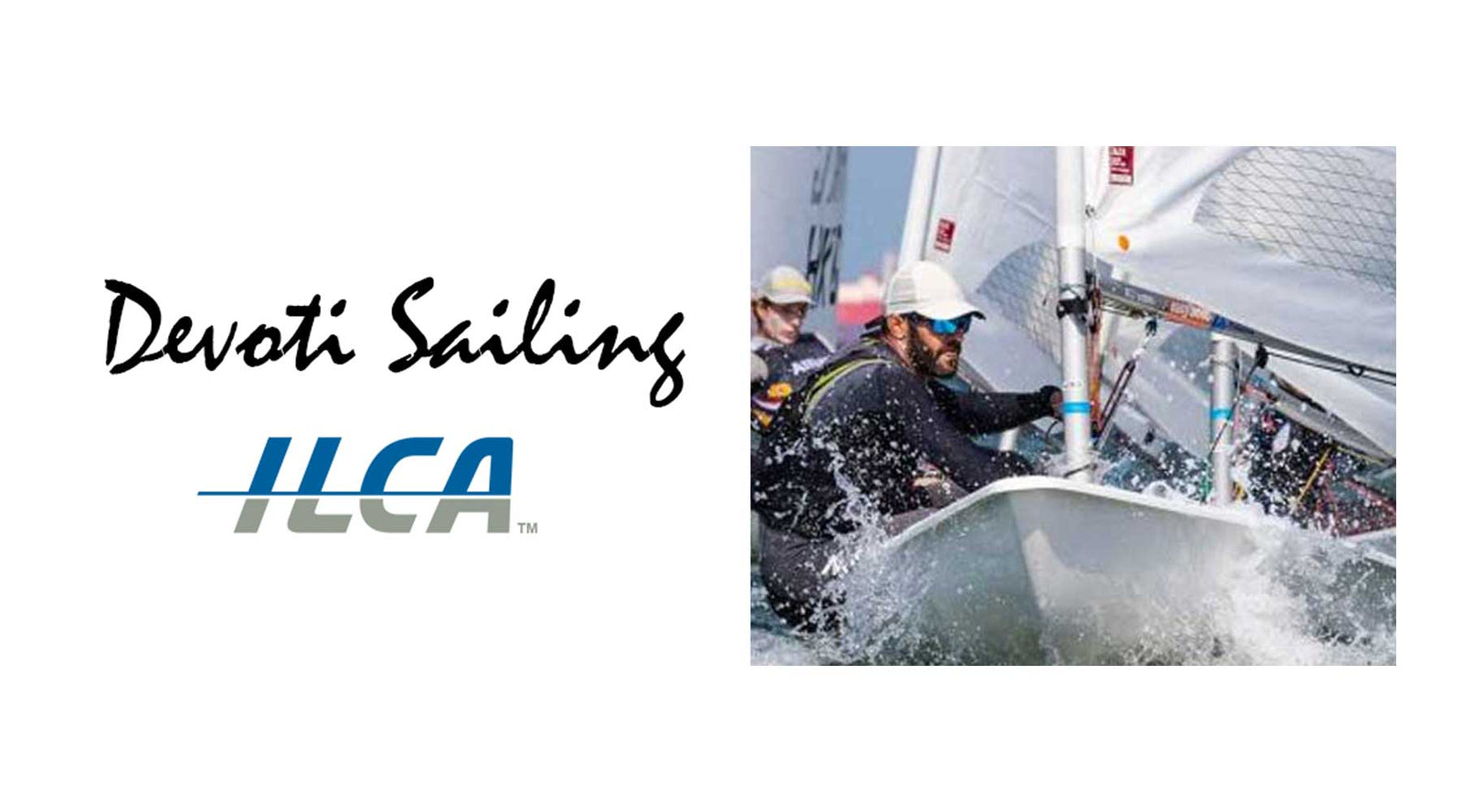 New Devoti ILCA Search our chandlery  Laser Sailing - Laser 8:1 Downhaul SystemSeptember 26, 2018 3 min read Laser 8:1 Downhaul SystemCurrent Laser National Champion and Sailing Chandlery sponsored sailor Sam Whaley explains how his Laser 8:1 Downhaul system is rigged and the ropes he uses. In 2016 the MK2 Laser Standard sail was released and amongst many small improvements on the previous design, the most notable change was an increase in cloth thickness used. Whilst this has meant that the sails are competitive for longer and harder wearing it does have some knock-on effects, such as controls being harder to pull on. This especially applies to the downhaul and with many people previously just using a 6:1 purchase it was simply not powerful enough to pull the correct amount of downhaul on in new sails. The Laser class rules allow a maximum purchase on the downhaul system to be 8:1 and many sailors started beefing up their systems by adding another block. This trend has swept across the Laser standard world over the past year with almost every single top sailor in the world using this 8:1 downhaul. Here we will take a look at my version of the 8:1 downhaul . I switched to this system at the beginning of 2018 and despite being sceptical at first it really does make a huge difference, allowing you to be able to depower the sail in the windy conditions even when hiking. I would recommend it to everyone sailing a standard rig and maybe even to small people in a radial who struggle to pull the downhaul on in the big stuff. Primary Rope LineFor my primary line I use some 5mm dyneema which goes through the sail and then around the gooseneck. I loop it around the gooseneck to avoid the rope getting caught in the boom and save a few grams of weight with less rope. Going any thinner with this primary is risky as there are such high loads on this rope if it snags on anything it can break easily.  I then used a Harken T18 block and attached it to the bottom of the top T29 block using some thinner dyneema. Whilst you can use a bigger block, a T18 block underneath makes the system flow easier as the secondary line does not rub upon movement, therefore less friction.  At the kicker fitting near the bottom I have a simple loop with another T29 block, held up by my sailing watch. Optimum Time Big Sailing Watch  My system works just like a 6:1 downhaul system, with an added block, so is very easy to rig and is just tied off at the bottom block by my watch as opposed to the top block by the foot of the sail.  As you can see by the picture above my downhaul system is also slanted forwards slightly to stop the rope getting caught in between the boom and the gooseneck. In conclusion the 8:1 downhaul system is a must have upgrade for Laser sailors, especially standard sailors, and really helps make your Laser easy to control. Products UsedHere are the products which are used for Sam's 8:1 Laser downhaul system: - 5mm Dyneema
- 4mm Evolution Race Dyneema Core rope
- Harken 29mm Soft Attach Block
- Harken 18mm Soft Attach Block
Want more content like this, and a first order discount?Sign up for more great articles like this and receive a unique first order discount code. Share your birthday too and we'll send you a gift for your special day. Recent Articles- ILCA Outhaul Calibration Markers
- ILCA Daggerboard Calibration Sticker
- 90˚ Marked Laser/ILCA Main Sheet - Sailing Chandlery
- Pre season Check List
- Where Should My ILCA Tell Tales Go
- What Are The Basic Tools Needed To Start Rope Splicing?
- You Don't Always Need Dyneema
- Boat Care and Cleaning Products
- Ropes for Club Boats and Club Dinghies - The Bosuns Guide
- Why You Should Use Two Sailing Watches
Let customers speak for ushad ordered one on amazon before, received the wrong size received the correct size now :) A simple moulded part of good quality, supplied quickly and well packed. Turned out that I had ordered the wrong make, my camcleats being Allen not Harken, however by drilling the two fixings holes out by 1mm and filing two small notches they fitted perfectly. Super helpful company. Attentive, and quick to deliver. Second time I have use for this purpose. Really easy to attach to alloy mast and so easy and positive to operate. We have put the boat on this trolley but not yet used it for launch and recovery. First impressions are very good, It fits together well and is super easy to assemble - it's made to put together and take apart fast if you want to put it in a vehicle etc. It is very lightweight which should be a boon launching and recovering the boat - at the same time it looks strong and well made. Being aluminium we won't have a rust problem either. I was impressed how it fits perfectly wherever it supports the boat. So assuming it performs well in use we are pleased we got this. Very helpful guy on the phone and it came quickly so all good, thanks, Good service, and fast delivery. Very happy with my large amount of assorted short lengths of rope of many different thicknesses for practising my knots. Good quality rope that can be spliced. Delivered promptly by the Sailing Chandlery. Excellent sail, ideal for training and comes with a sailbag, Our only drawback was the long delivery time (2-3 weeks) and having to pay €90 in customs charges all due to Brexit! If Sailing Chandlery had a outlet here in the Republic or in Northern Ireland, business could get much better. Worked a treat The Puco hatches I bought hatch really well for hatchy things. Speedy service and great value. Hatch-on! My Topper sails infinitely better with this new sail, , much faster, came with strap and eye at head, had to unpick and remove the strap to work with my halyard loop. David I have used Sailboats Chandlery before and as before the service was great and the product as per description. A great and speedy service. I highly recommend Sailboats Chandlery. I took advantage of the offcut sale to try out some of the more expensive ropes for my limited needs. I have not seen this kind of offer before, and I was able to find some lengths and qualities I would not normally worry about. Great service and sensible prices. Customer focused offers. I also plan to use some of the offcuts to improve my whipping and splicing. Does my son know he is being towed down the Thames with a rope that would be on the more expensive yachts with a breaking strength well over what we need, no. Does it matter - actually yes it does :) Useful pack for spares box We received the electric very quickly and it is of great quality. We will definitely use sailing chandlery again. SIGN UP TO OUR NEWSLETTERSave up to 40% on your next order. 10% Off Hobie Parts / 15% Off Rigging / 10-15% Off Select Kayaks - SHOP NOW  - Call Us +1-503-285-5536
- Sign in & Register
- Recently Viewed
- One Design Parts
- Club 420 Parts
Tillers & BladesC420 sail boat blades including centerboards, rudders, rudderheads, tillers, tiller extensions, and more.  C420/FJ Tiller (Zim) C420 Rudder (Rigged, V1, White) C420/FJ Tiller With 33 In Extension C420 Rudder (Rigged, V2, White) C420 Rudder Retainer Clip Lift Stop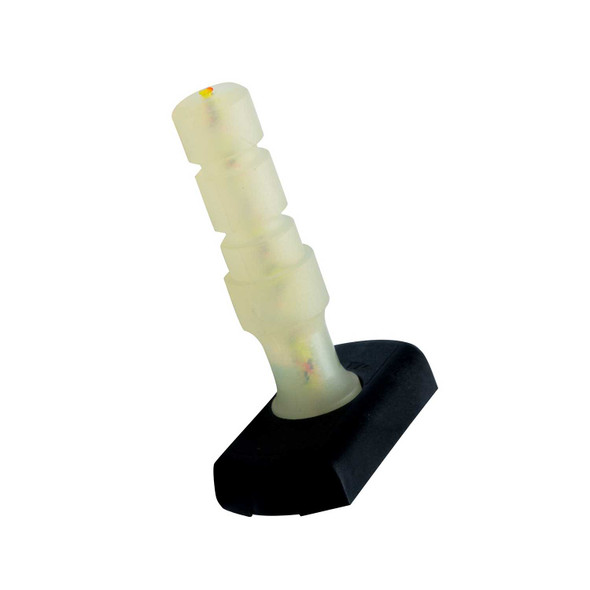 Omniflex Tiller Joint Universal w/ Rope Core C420 Tiller with Extension Omniflex Tiller Joint Universal C420 Rudder Head C420 Rudder Blade Harken Tiller Extension 420 Centerboard- Total: items /
- Add all to cart
Adding your products to cartSubscribe to our newsletter. Sign up for our newsletter to receive exclusive discounts, new product announcements, and upcoming sales.  - Forums New posts Unanswered threads Register Top Posts Email
- What's new New posts New Posts (legacy) Latest activity New media
- Media New media New comments
- Boat Info Downloads Weekly Quiz Topic FAQ 10000boatnames.com
- Classifieds Sell Your Boat Used Gear for Sale
- Parts General Marine Parts Hunter Beneteau Catalina MacGregor Oday
- Help Terms of Use Monday Mail Subscribe Monday Mail Unsubscribe
Final Word on rudder downhaul- Thread starter Brigg
- Start date Feb 12, 2003
- Hunter Owner Forums
- Smaller Boats
I think there must be a cap on the number of responses and the time on active status for any one topic in this forum, as my last post on this subject did not show up and the topic is sinking fast. Here is what I heard from Hunter Marine on the 260 rudder.�I received the following E-mail yesterday from Greg Emerson at Hunter Marine:�-------------------------------------------��Mr. Franklin,�Adding a metal strip to the bottom of the rudder would not create a dangerous situation but I would be concerned that the modification, when complete, would seal the rudder. Otherwise you would take a chance of water intrusion into the foam core. The reason that the rudder is buoyant is to make up-haul of the rudder easier. In previous years the rudder was cored with a structural polyester adhesive and the rudder was much heavier than the current foam cored rudder. During that time we received complaints that the weight contributed to the difficulty in raising the rudder. ��New Hunter 260's in current production are designed with a plastic pin that is put in�place to hold the rudder in the down position while under way but can easily be sheared off if the rudder were to hit something. Therefore the chance of rudder damage is minimized.��I hope that this information is helpful. �Thanks��Greg Emerson�-----------------------------------��I think I'll see how much weight it takes to make the rudder neutrally buoyant, and then how hard it is to haul it back up. Then decide if I want to permanently attach some weight and seal the rudder.��Brigg Scott BlahnikThat's useful You stuck with it and at least got some answers. I thought my rudder was made of styrofoam to cut corners on cost. And I wondered why it didn't have a pin in it, which seemed to make sense. My dealer put a pin in which I never use, now I can see that it may be best that I continue not using it(as it doesn't shear).�The topic won't go away though,I guarantee!�Scott�S/V Hello Dolly  Phil HerringWhen forum posts go away Hi Brigg,��Your earlier reply is at the tail end of the replies to the existing thread... posts are not removed until they have received no replies for 7 days.��ph. - This site uses cookies to help personalise content, tailor your experience and to keep you logged in if you register. By continuing to use this site, you are consenting to our use of cookies. Accept Learn more…
 |
IMAGES
VIDEO
COMMENTS
The Laser 8:1 downhaul is a popular upgrade to allow you as the sailor to have more control over your sail, which needs de powering on those windy days. In this article we walk you through what you'll need and how to make a Laser 8:1 downhaul system step by step.
With this setup, you can leave your rudder attached to the tiller under your boat cover - this saves time for each sailing session. We also cover how to handle the "fixed" setup while launching ...
A Simple Rudder Downhaul. First, a confession up front. This article will not present any ingenious new idea, or reveal some lost secret of the ancient boatbuilder's art. In fact, most boatbuilders likely already have their own favorite rudder downhaul systems. This is merely a greenhorn's account of one step in a long journey on the ...
Rudder Tie Down To secure my tiller after I've launched I put the rudder blade all the way down and then tie a simple slip knot in the rudder downhaul rope before passing the rope under the notch in the cleat, through the loop in the slip knot and then back through the cleat on the tiller before pulling on hard and cleating off.
Complete Assembly: ILCA Rudder Blade, ILCA Rudder Head, 10mm Pivot Bolt, and 4mm Downhaul Line. Class legal for all International Laser Class Association sailing.
My H23 has a cam style cleat (with the serrated jaws) that holds the downhaul line tight, mounted to the top of the aluminum rudder head. I did once touch a rock with the rudder down, while motoring at maybe 4 or 5 knots. The downhaul line pulled through the cam jaws, stripping the outer line covering from the core, in effect releasing it.
The downhaul line is basically just to keep it from floating back up while underway. I wish I had a picture, but my uphaul is just on a bracket mounted to the trailing edge of the rudder and pulls it up to a clam cleat.
Join Date: Mar 2011. Location: Southport CT. Boat: Sabre 402. Posts: 2,815. Re: Rudder Downhaul. Further explanation about removable pin helps. Using a pin with a tapered end will help make it easier to insert while you try to line up the rudder with the hole as the boat bobs around in the water.
Build two simple light strong rudderboxes for the Viola 14 sailing canoe and sailboats Simpler method of making a rudder setup for sailboats including the Viola 14 canoe is a direct descendant of our original dagger rudderbox carrying on the light but strong and easy to build construction. This article is a resource for sailing canoe and outrigger canoe rudder builders.
I would like to propose a group project, here on hunterowners.com, to improve the rudder downhaul system used on the 240/260 water ballast boats, with a swing rudder. This is a less than perfect system, on a great boat, that good minds should be able to improve. \u000B1. The first problem is how to...
The downhaul connects to the cable which runs around the back of the tiller and is cleated on top of the tiller -often with a release cleat. There is also an uphaul line to raise the rudder, and can be cleated at the tiller as well. Red line is the downhaul and green line is the uphaul.
Current Laser National Champion and Sailing Chandlery sponsored sailor Sam Whaley explains how his Laser 8:1 Downhaul system is rigged and the ropes he uses.
The boom vang doubles as our preventer.u000bu000bAlso, as previously mentioned, make sure the downhaul is centered on the edge of the rudder as it is lowered. I would remove the downhaul altogether if it weren't for the fact that the rudder never goes down the last inch without it.
I just got my new 2012 Laser, race rigged. I would like to know the exact route the rudder downhaul line should take to the tiller, especially thru the bottom of the two horizontal rods or pins that connect the metal sides. It seems likely that the line needs to be aft of the top pin, but if...
Description Downhaul line for the Laser rudder, pre-cut from 4mm Robline Sirius line for your convenience to 4 feet.
How does one go about replacing the rudder downhaul line for a 192? That line goes in, and I don't seen a corresponding hole for it to come out, or be knotted, etc. I see what appears to be a plugged up hole on the side of the rudder blade, below where the line goes in. Is this supposed...
C420 Rudder (Rigged, V2, White) Zim Sailing. $640.00. Complete rigged rudder including rudder head, blade, and downhaul. Zim V2 rudders are only compatible with Zim C420s. To fit on a PS2000, Vanguard, or LP boat you must order the V1 rudder. Zim 420 rudder blades have a seamless edge that makes for a...
You cleat the rudder downhaul and upon impact the cleat "breaks away" and releases the downhaul. Every boat I sell (am a dealer of small beach cats from multiple manufacturers) has this style.
May 10, 2004. #11. 240 rudder cleat. I can lower my rudder without stepping on it by raising the tiller way up, pull the downhaul tight and take a wrap on the cleat, lower the tiller, repeat. this way I ratchet the rudder down in about 4 repetitions. I like the idea of the releasing cleat for running aground.
I think there must be a cap on the number of responses and the time on active status for any one topic in this forum, as my last post on this subject did not show up and the topic is sinking fast. Here is what I heard from Hunter Marine on the 260 rudder.\u000BI received the following E-mail...